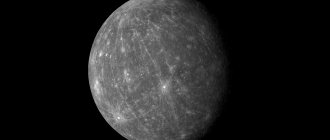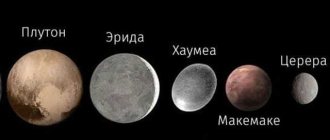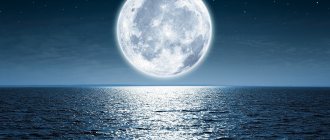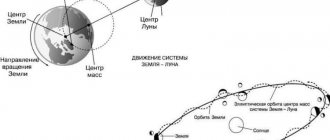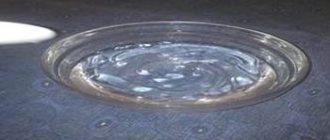general description
Among the terrestrial planets in the solar system, which includes Mercury, Venus and Mars, Earth is the largest. The planet is the third in distance from the Sun, it is the fifth in diameter, mass and density. The age of our planet is compared to the age of the entire solar system and is approximately 4.5 billion years. There is a hypothesis that the Earth was formed from gas and dust that remained from the formation of the sun. The oldest rocks that have been studied were formed approximately 100 - 200 million years ago. And conditions favorable for the emergence of life on the planet arose only 3.5 billion years ago. We, as a modern type of person, were formed only 40,000 years ago.
The earth is spherical in shape, flattened at the poles. The length of the Earth's equator is 40,076 km, the equatorial radius is 6,378 km, the polar radius is 6,357 km and the average radius is 6,371 km.
The Earth, and we along with it, revolves around the Sun in a circular orbit, the radius of which is 150 million km. The period during which the Earth rotates in an elliptical orbit occurs at a speed of 29.8 km/s and lasts 365 days. The approximate distance to the Sun is 149,543,000 kilometers.
The earth also rotates around its imaginary axis (from west to east). A full revolution is completed in approximately 23 hours 56 minutes. The rotation axis is tilted 66.5 degrees relative to the orbital plane, and as a result of this movement, the cycle of day and night occurs. And since the earth simultaneously rotates around the Sun, sometimes approaching and sometimes moving away from it, the seasons change.
Discovery, study and transformation of the Earth - a planet of the solar system.
Sciences studying nature gradually emerged and began to develop.
—What was nature called in the old days? (nature)
Therefore, the sciences of nature received the general name natural sciences.
.
Astronomy (“astron” - star, “nomos” - law) is the science of celestial bodies.
Physics (“physics” - nature) is the science of natural phenomena.
Chemistry (origin unknown) is the science of substances and their transformations.
Biology (“bios” - life, “logos” - science, teaching) is the science of living nature.
Ecology (“ekos” - house, “logos” - science, teaching) is the science of the relationships of organisms with each other and with their environment, of the interaction between man and nature.
Geology (“geo” - earth, “logos” - science, doctrine) is the science of the Earth, its form, structure, composition and development.
Geography (“geo” - earth, “grapho” - writing) - “geographic description”, the science of the Earth.
II . Updating knowledge.
— How was knowledge about the Earth accumulated? (traveling)
— What travelers do you know?
III . Learning new material.
Using the textbook text, fill out the table.
| Name | date | Achievement |
| Aristotle | 384-322 BC | Sphericality of the Earth |
| Eratosthenes | 276-194 BC | Measured the circumference of the Earth. |
| Herodotus | 484-425 BC | Study of the southern regions of the East European Plain. |
| Marco Polo | 1271-1295 | For 24 years he traveled and studied Asia. |
| Vasco da Gamma | 1497-1499 | He was the first to pave the sea route to India. |
| Christopher Columbus | 10/12/1492 | Discovered a new part of the world - America. |
| Fernand Magellan | 1519-1522 | Made the first trip around the world. |
| M.P. Lazarev, F.F. Bellingshausen | 1820 | The sixth continent was discovered - Antarctica. |
The sun and the celestial bodies moving around it make up the solar system
.
Planets are divided into two groups: terrestrial planets and giant planets.
Terrestrial planets
much smaller in size and closest to the Sun.
Name them. (Mercury, Venus, Earth, Mars)
Giant planets
consist of gases, primarily hydrogen, do not have solid surfaces, and are far from the Sun.
List them. (Jupiter, Saturn, Uranus, Neptune)
Pluto is not included in any group
- dwarf planet. Pluto is still little studied; it was discovered only in 1930.
Work according to fig. 4 page 8.
Which planet in the solar system is the largest? (Jupiter)
What is the total number of planets? (8)
Name the planet closest to the Sun. (Mercury)
Which planet has rings? (Saturn)
Name the Earth's neighbors. (Venus, Mars)
Which planet occupies the third orbit? (Earth)
What is the center of the solar system? (Sun)
The Earth, like other planets, moves around the Sun. This path of the Earth is called an orbit
.
The Earth's orbit is ellips
.
Simultaneously with its movement around the Sun, the Earth rotates around its axis (counterclockwise). Earth's axis
is an imaginary straight line passing through the center of the Earth.
Structure of the Earth
Based on various studies, scientists have divided the Earth into three parts - core, mantle and crust.
The core is the heaviest part of our planet, its radius is about 3500 km, and its temperature is 4000 degrees and above. It is supposedly divided into an outer liquid part, consisting of sulfur and iron, and a solid inner part, containing an alloy of iron and nickel.
The mantle is not yet available for full research, so all data was obtained using geophysical and geochemical methods. It is in a solid state, from 30 to 3000 km from the surface and consists of ultrabasic rocks, refractory elements.
On top of the mantle lies the earth's crust, consisting mostly of rocks and minerals. It is on it that the oceanic and continental crust is located. Its thickness ranges from 5 to 10 km under water and up to 80 km on land.
Scientists have hypothesized that the oceanic crust was initially formed, and as a result of various processes that occurred inside the planet, folds were formed - sections of mountains. Over time, the thickness of the crust increased, forming the continental crust.
General characteristics of the Earth
The planet's surface consists of 80% water and only 21% land, which consists of 6 continents (Eurasia, Africa, Australia, North and South America, Antarctica), and a large number of islands.
The continents are separated by oceans and differ in geological structure. Modern outlines were obtained as a result of the movement of lithospheric plates. There are two types of continental structure: folded belt and platform.
The platform is the most stable section of the earth's crust; earthquakes do not occur here. Examples of platform regions are Siberian, African, Hindustan, North American, South American, Australian and Eastern European.
Fold belts include: the Pacific, Ural-Mongolian, Mediterranean, North Atlantic and Arctic belts.
The largest continent is Eurasia, which includes Europe and Asia, the smallest is Australia.
The highest point is Mount Everest, 8852 meters above sea level.
And you can’t ignore the Kola superdeep well, which is the result of human activity and is included in the Guinness Book of Records. It is located in the Pechenga district of the Murmansk region, near the city of Zapolyarny. The depth of this well is 12262 meters.
The planet has four main climatic zones - equatorial, tropical, temperate and polar. There are also four transitional ones - subequatorial, subtropical, subarctic and subantarctic.
At the equator the highest temperatures reach + 70, and the coldest is in Antarctica, where the thermometer drops to -85. The average t on the planet is approximately 12 degrees.
View of planet Earth
Hydrosphere
Water was not discovered on any of the planets. Our planet is the only one with a hydrosphere, and its most important part is the World Ocean. The world ocean is conventionally divided into the Pacific, Atlantic, Indian, and Arctic oceans. The lowest point, 11,022 meters below sea level, is located in the Mariana Trench, Pacific Ocean. The world's oceans are the most active participant in the water cycle in nature.
What is the atmosphere for?
Our planet is protected from many unpleasant things by the atmosphere, a kind of shield. Thanks to it, meteorites that burn in the upper layer do not reach the planet; it is precisely it that does not allow dangerous ultraviolet radiation to pass through.
Many have seen the mesmerizing photographs of the Earth taken by astronauts. shrouded in clouds and emitting blue light - the most beautiful planet. This glow is possible thanks to oxygen, which is contained in the air and makes up 21% of the total volume. 80% is nitrogen content, approximately 1% is argon, and the remaining gases: carbon dioxide, neon, methane, helium and others complement the composition of the air.
The lowest layer is the troposphere; the presence of this layer makes the stay of all life on Earth comfortable, because it contains up to 80% of atmospheric air. The troposphere extends up to 8 km in the north and up to 18 km in the south from the surface of the planet. This is the main “forge” of weather and climate on Earth - cyclones, anticyclones, clouds and winds are all formed in this layer.
Then comes the stratosphere - the ozone layer located here blocks solar radiation. Ozone occurs when oxygen reacts photochemically with ultraviolet radiation. Located at an altitude of 11 to 50 km. Airplanes fly in the lower layers of the stratosphere.
The mesosphere extends its boundaries up to 90 km. Meteors begin to burn up in this layer. Scientists have nicknamed it the “ignorosphere” because it is the least studied layer in the atmosphere.
The thermosphere originates at an altitude of 90 km and extends up to 800 km. Unmanned satellites fly here.
Exosphere - begins above 500-1000 km and gradually passes into the vacuum of space.
In addition to the atmosphere, we are also protected by the Earth’s magnetosphere - the outer and longest shell. This sphere does not allow solar and cosmic radiation, which is harmful to all living things, to penetrate to the earth. Scientists are still studying the origin of the magnetic field.
By the way, thanks to the magnetosphere, people admire the northern lights. Charged particles of the solar wind are successfully reflected, but some lucky ones manage to penetrate the magnetic field. When they collide with molecules of oxygen (red, yellow, green) and nitrogen (shades of purple and blue), they form a beautiful glow.
The best places for observation are the north of Russia, Norway, Finland, Sweden, Iceland, Canada, as well as Alaska and Greenland. The best period is from October to February. The main thing is that there are no city lights nearby, and the sky is free of clouds. We will get acquainted with the structure of the Earth in more detail in the following articles.
Summary of the lesson on the surrounding world “Earth is the planet of life”; 2nd grade
Evaluation paper
| Lesson stage | Made it easy | Completed the hint | Did not cope |
| Modeling | |||
| Solar System Map | |||
| Crossword | |||
| Determining the topic of the lesson | |||
| Conclusions about planet Earth | |||
| Creative task | |||
| Working with the textbook | |||
| A Tale for an Alien | |||
| How did I work? |
Astronomers:
Earth is the third planet from the Sun in the solar system.
Our planet is surrounded by an atmosphere. It, like a blanket, envelops the Earth and retains the heat received from the Sun. In addition, it protects the planet from “extra” solar rays: it lets in as much of it as is needed for life.
Only on our planet there is liquid water. It was in water that life on Earth originated!
Evaluation paper
| Lesson stage | Made it easy | Completed the hint | Did not cope |
| Modeling | |||
| Solar System Map | |||
| Crossword | |||
| Determining the topic of the lesson | |||
| Conclusions about planet Earth | |||
| Creative task | |||
| Working with the textbook | |||
| A Tale for an Alien | |||
| How did I work? |
Farmers:
On our planet, most of the land is covered with soil, because only on it can plants develop - a source of food for people and animals!
Only on our planet there is enough air and sun for plant life, and there are no sudden temperature changes. Which allows many trees and vegetables to grow and ripen.
Travelers:
There are many beautiful places on our planet: mountains, seas, meadows and forests.
You can walk and go west, east, north or south. Everywhere you will meet interesting people, big cities, funny animals and the endless beauty of nature. And in order to preserve life on the planet, let's take care of all this, without disturbing the natural balance, live without offending each other, without offending our smaller brothers. And the sky above us will be blue!
Test.
1) What shape does the Earth have?
a) triangle b) square c) sphere.
2) Why is the Earth called the “blue planet”?
a) the surface is covered with water from the seas and oceans b) painted with blue paint c) covered with ice
3) How far is the Earth from the Sun?
a) 7 b) 3 c) 5
4) Which planets are Earth's neighbors?
a) Mars and Venus b) Pluto and Venus c) Mars and Jupiter
5) Which planet of the solar system is called “red”?
a) Neptune b) Saturn c) Mars
Test.
1) What shape does the Earth have?
a) triangle b) square c) sphere.
2) Why is the Earth called the “blue planet”?
a) the surface is covered with water from the seas and oceans b) painted with blue paint c) covered with ice
3) How far is the Earth from the Sun?
a) 7 b) 3 c) 5
4) Which planets are Earth's neighbors?
a) Mars and Venus b) Pluto and Venus c) Mars and Jupiter
5) Which planet of the solar system is called “red”?
a) Neptune b) Saturn c) Mars
Test.
1) What shape does the Earth have?
a) triangle b) square c) sphere.
2) Why is the Earth called the “blue planet”?
a) the surface is covered with water from the seas and oceans b) painted with blue paint c) covered with ice
3) How far is the Earth from the Sun?
a) 7 b) 3 c) 5
4) Which planets are Earth's neighbors?
a) Mars and Venus b) Pluto and Venus c) Mars and Jupiter
5) Which planet of the solar system is called “red”?
a) Neptune b) Saturn c) Mars
Test.
1) What shape does the Earth have?
a) triangle b) square c) sphere.
2) Why is the Earth called the “blue planet”?
a) the surface is covered with water from the seas and oceans b) painted with blue paint c) covered with ice
3) How far is the Earth from the Sun?
a) 7 b) 3 c) 5
4) Which planets are Earth's neighbors?
a) Mars and Venus b) Pluto and Venus c) Mars and Jupiter
5) Which planet of the solar system is called “red”?
a) Neptune b) Saturn c) Mars
Earth's satellite - Moon
The only object in space where a man landed. The distance to the Moon is approximately 384,470 km. The Moon has the same structure as the Earth or Venus. This is the core, mantle, crust. The diameter is approximately 3474 km. There is no atmosphere suitable for life, so we cannot live on it. The Moon rotates around the Earth in an elliptical orbit with a period of 27 days. Also, the Moon rotates around its axis, but only one side faces the Earth. From Earth we see only the part of the Moon's surface illuminated by the Sun.
The influence of the Moon on the Earth is very great. Due to its proximity, the Moon influences the ebb and flow of the tides and changes in the magnetic field. The Moon also intercepts meteorites flying towards the Earth.
Basic information about Earth
Surface area - 510.072 million km2. 6 continents, home to ~7.3 billion people (as of 2020) and the population gradually continues to increase.
The earth rotates around its axis. And one revolution takes about 23 hours and 56 minutes. But for convenience, a day is 24 hours. An interesting fact is that the rotation gradually slows down. Only these changes are so insignificant that they can only be noticed over huge periods of time. For example, over the past couple of thousand years, rotation has slowed down by 0.0023 seconds (based on these data, it can be assumed that in 3 billion years the length of the day will be 25 hours).
The planet itself rotates around the Sun at a tremendous speed - about 30 km/s. It completes a revolution in 365 and a quarter days (because of this, every fourth year is a leap year, 366 days). 1 a.u. (astronomical unit) - the average distance between the Earth and the Sun.
Well, its satellite, the Moon, revolves around the Earth. A full revolution takes just over 27 days.
The solar system itself, in which all this is happening, also does not stand still. It moves at a speed of about 20 km/s to the intersection point of the constellations Lyra and Hercules.
Asteroids are another type of celestial body that can have an impact on the planet. A collision with them can lead to the destruction of the Earth's biosphere (all living things) or even the destruction of the planet. Judging by the impact craters formed after the fall of meteorites, they have already caused several global catastrophes (the disappearance of a large part of living organisms 250 million years ago and the extinction of dinosaurs).
